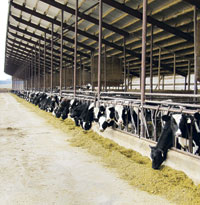Dairy Event 2010: VIDEO – Industry needs to tackle super-dairy questions

Consumer opposition to large-scale dairying requires the industry to step up and promote the positive story which is there to be told.
A recent survey by The World Society for the Protection of Animals found two-thirds of shoppers said they would not buy milk from large scale, indoor dairy units.
But speaking at the Dairy Event and Livestock Show, Sian Davis, NFU dairy adviser, said there was a need to inform consumers that all systems can work.
“The whole supply chain needs to be involved in promoting what we do so well. We need to be ‘one voice’ for the industry.”
Jim Begg, Dairy UK‘s director general, said what needed to be made clear was that welfare was paramount and it was up to the industry to reassure consumers on these points.
“The job needs to be done. The science is there and the story is there to give a convincing message to the consumer.”
To provide consumers with accurate information, DairyCo has launched a website www.thisisdairyfarming.com designed to be a “one stop shop” for dairy facts.
However, according to Amanda Ball, head of communications for DairyCo, the strongest challenge comes from the campaign groups, rather than the consumer.
“There has been a lot of highly emotive language pushed out through campaign groups, some of which is not always factually correct.
“It is important to differentiate between genuine consumer concerns and those of the pressure groups,” she stressed.
In fact, a quarterly tracking survey carried out by DairyCo found that more than half of those surveyed had no fixed opinion on large-scale dairying.
“What was of real concern to the consumer was the health and welfare of cows rather than the scale of the farm itself.”
In responding to campaign groups, RABDF chairman David Cotton said it was all about a softly, softly approach in getting them to understand what the farming industry’s message was.
“The issue of large-scale dairying has highlighted there’s a big difference between what farmers know about dairy farming and what the consumer does.
“Farming has gone back up the ladder as far as consumer awareness, so it’s a good opportunity to do something about it,” he said.
From the FWi forums – consumer attitudes to super-dairies
“Will we be able to tell that the milk and other by-products come from a super dairy? As a consumer this is something I would want to know and I wonder if I will be able to tell. I think you need to bear in mind that the dairy consumers do have emotions and make many decisions based on them each day.” Cel
“I’m not sure what the public perception would be of keeping such a large herd indoors. Should we be aiming for the clean green ‘happy’ cows outdoors image that the Kiwis market their dairy produce with? Or are our consumers both here and abroad not interested where their milk comes from and these large units will become the norm?” Mud on Boots
“I produce ‘free-range milk’. You may think that is a superior product to what will be produced at Nocton. Would you, as a consumer, be prepared to pay a premium for it? The problem with consumers is that they tend not to “walk it like they talk it”. A vocal minority will say, “Yes, we’ll pay a premium for organic and the like”, and then say “Hmm, money’s a bit tight this week, we’ll make do with the cheap stuff.” Up the rams
• Add your comments to the forum. And for more from the Dairy Event and Livestock Show click here.
dairynews
